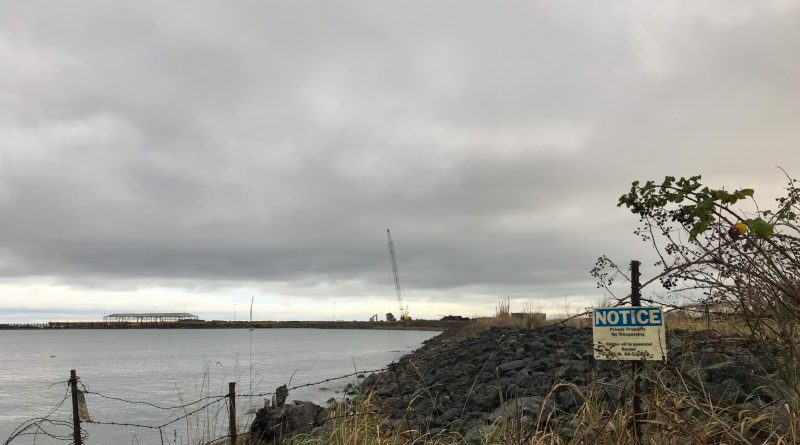Not Here! But Where?: Contaminated Soil on an Old Mill Site
I came to Port Angeles, Washington (where part of my family recently moved) in March, when college went remote and life as we knew it began to end. It’s a good place to be during a pandemic—there aren’t many people and there is an abundance of trails to safely wander.
One such trail is the Olympic Discovery Trail, which spans most of the Northern Olympic Peninsula. I often run from the Port Angeles City Pier East on this trail. In a city where the Olympic Mountains rise up from the Salish Sea, it’s one of the few places to run that’s relatively flat. But more importantly, there’s a meditative beauty to the area. On one side of the trail, there are forested bluffs that hide the medical center, neighborhoods, and roads above. On the other side, there is the sea. The sea there is calm and reflective, usually mirroring the colors of the sky. Depending on the day and time, the North Cascades appear in the distance as blue-grey shadows, radiant clouds, or not at all, hidden by fog or rain.
It’s Not All “Pristine” Natural Beauty
Less than a mile in, there’s a stretch of trail where the distance between the trail and sea widens. A wire fence with “No Trespassing” signs appears, as do an assortment of idle structures behind it. This 75 acre area was once inhabited by the Rayonier Pulp Mill. In 1945, the mill was the largest timber owner on the Olympic Peninsula. And for most of the 20th century, it was the largest employer in the county. Then came the fall of the logging industry and, with it, the fall of the Rayonier Pulp Mill in 1997. The jobs were gone, soon many of the structures were gone, but less conspicuous traces remain.

Less conspicuous, but quite toxic. I’m talking polycyclic aromatic hydrocarbons, heavy metals (including arsenic and lead), dioxins, polychlorinated biphenyls, and ammonia. Most of these contaminants were released through boiler smoke and untreated wastewater. They are now not only contained in the soil of the 75 acre site, but also in that of the 1300 acres of marine area extending from the shoreline to the sea. These contaminants are very harmful to our health and to that of other organisms. What’s more, fish and clams accumulate them in their tissues. This is not great for them. It’s also not great for the people who eat them.

In 2004, Rayonier reorganized as a Real Estate Investment Trust with three focuses: forest resources, real estate, and performance fibers (in 2014, this last focus became its own independent, publicly traded company). Rayonier owns land in the U.S. Pacific Northwest, U.S. South, and New Zealand, and its market capital is over $4 billion. Under the Washington Department of Ecology, Rayonier is working to mitigate the contaminated soil’s potential health harms. By 2011, they had removed approximately 90% of the contaminated soil. This included over 24,000 tons of petroleum-contaminated soil and concrete, 2,700 cubic yards of petroleum-contaminated wood residue, 2,500 sunken logs, and 4,800 tons of soil. But much remains.
That was nearly a decade ago, and little has happened since. Now, a couple of options are being considered. For the site, Rayonier is considering either hauling away the contaminated soil or placing a cap on it. For the marine area, they are similarly considering dredging it or capping it.
Many residents of Port Angeles and regional environmental activists are not into the idea of capping the soil. One of their main concerns is that people would likely be requested to limit their visits to twice a week, as capping wouldn’t actually remove the contaminants. What would happen if you went three times in one week? You don’t want to know… (Likely not much, unless you came into direct contact with the soil.)
It’s important to note that Rayonier’s proposal to cap the soil would cost them $7.4 million. Hauling away all the contaminated soil, however, would cost them $37 million. Though this is an enormous difference, I’m not too worried about Rayonier’s pockets. However, I am worried about another component that’s gotten far less attention.
Haul It Away, and That’ll Be the End of It. Right!?
We’ve known for a long, long time that the earth is a closed system for matter. There is no magical place where we can throw things away and they’ll vanish forever. So, we need to talk about where the contaminated soil would be hauled away to. Sure, a waterfront property near downtown is not the best place for toxic waste. But neither is a landfill near, say, a low-income and/or predominantly BIPOC neighborhood. Alternatives to landfills include incineration (though that causes significant air pollution) and landfarming or bioremidiation, which facilitate microbes metabolizing the waste. There’s no perfect solution, but discussing hauling away contaminated soil without discussing where it would be hauled away to will only perpetuate the close-mindedness that created this problem in the first place.
With the sun setting as soon as it has risen, the sky often begins to darken as I head back on my runs. There’s an old dock on the Rayonier Mill site. It is long, and the end is covered by a graying, white roof. When I see it at this time of day, I imagine a lively outdoor events space. I imagine music playing and people dancing under sparkling lights. Maybe one day such a space will exist. (This is more than a pipe dream—the Jamestown S’Klallam Tribe is proposing a Salish Village—a mixed-use commercial and residential center, which would include an intertribal cultural center and a restored pier.) But for now, there is no music playing and no people dancing. And, rather than lights, there is only the sparkle of contaminants, buried in the dark soil and under the glassy sea.







